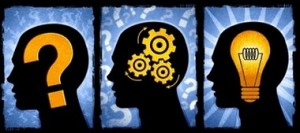Critical Thinking: Critical Reading Strategies
 CRITICAL READING STRATEGIES
CRITICAL READING STRATEGIES
(from Longview Community College, Lee’s Summit, Missouri)
These seven critical reading strategies can be learned readily and then applied not only to reading selections in a Literature class, but also to your other college reading. Mastering these strategies will help you handle difficult material with confidence.
- Annotating:Fundamental to each of these strategies is annotating directly on the page: underlining key words, phrases, or sentences; writing comments or questions in the margins; bracketing important sections of the text; constructing ideas with lines or arrows; numbering related points in sequence; and making note of anything that strikes you as interesting, important, or questionable.
- Most readers annotate in layers, adding further annotations on second and third readings.
- Annotations can be light or heavy, depending on the reader’s purpose and the difficulty of the material.
- Previewing: Learning about a text before really reading it. Previewing enables readers to get a sense of what the text is about and how it is organized before reading it closely. This simple strategy includes seeing what you can learn from the headnotes or other introductory material, skimming to get an overview of the content and organization, and identifying the rhetorical situation.
- Contextualizing:Placing a text in its historical, biographical, and cultural contexts. When you read a text, you read it through the lens of your own experience.
- Your understanding of the words on the page and their significance is informed by what you have come to know and value from living in a particular time and place. But the texts you read were all written in the past, sometimes in a radically different time and place.
- To read critically, you need to contextualize, to recognize the differences between your contemporary values and attitudes and those represented in the text.
- Questioningto understand and remember: Asking questions about the content. As students, you are accustomed to teachers asking you questions about your reading.
- Questions are designed to help you understand a reading and respond to it more fully, and often this technique works.
- When you need to understand and use new information though it is most beneficial if you write the questions, as you read the text for the first time.
- With this strategy, you can write questions any time, but in difficult academic readings, you will understand the material better and remember it longer if you write a question for every paragraph or brief section.
- Each question should focus on a main idea, not on illustrations or details, and each should be expressed in your own words, not just copied from parts of the paragraph.
- Reflectingon challenges to your beliefs and values: Examining your personal responses. The reading that you do for this class might challenge your attitudes, your unconsciously held beliefs, or your positions on current issues.
- As you read a text for the first time, mark an X in the margin at each point where you fell a personal challenge to your attitudes, beliefs, or status.
- Make a brief note in the margin about what you feel or about what in the text created the challenge.
- Now look again at the places you marked in the text where you felt personally challenged.
- What patterns do you see?
- Outlining and summarizing: Identifying the main ideas and restating them in your own words.
- Outlining and summarizing are especially helpful strategies for understanding the content and structure of a reading selection.
- Whereas outlining reveals the basic structure of the text, summarizing synopsizes a selection’s main argument in brief.
- Outlining may be part of the annotating process, or it may be done separately (as it is in this class).
- The key to both outlining and summarizing is being able to distinguish between the main ideas and the supporting ideas and examples.
- The main ideas form the backbone, the strand that hold the various parts and pieces of the text together.
- Outlining the main ideas helps you to discover this structure.
- When you make an outline, don’t use the text’s exact words.
- Summarizing begins with outlining, but instead of merely listing the main ideas, a summary recomposes them to form a new text. Whereas outlining depends on a close analysis of each paragraph, summarizing also requires creative synthesis. Putting ideas together again — in your own words and in a condensed form — shows how reading critically can lead to deeper understanding of any text.
- Evaluating an argument means testing the logic of a text as well as its credibility and emotional impact. All writers make assertions that want you to accept as true.
- As a critical reader, you should not accept anything on face value but to recognize every assertion as an argument that must be carefully evaluated.
- An argument has two essential parts: a claim and support.
- The claim asserts a conclusion — an idea, an opinion, a judgment, or a point of view — that the writer wants you to accept.
- The support includes reasons (shared beliefs, assumptions, and values) and evidence (facts, examples, statistics, and authorities) that give readers the basis for accepting the conclusion.
- When you assess an argument, you are concerned with the process of reasoning as well as its truthfulness (these are not the same thing).
- At the most basic level, in order for an argument to be acceptable, the support must be appropriate to the claim and the statements must be consistent with one another.
- Comparing and contrasting related readings : Exploring likenesses and differences between texts to understand them better.
 Many of the authors on the subject of thinking critically approach the topic in different ways. Fitting a text into an ongoing dialectic helps increase understanding of why an author approached a particular issue or question in the way he or she did.
Many of the authors on the subject of thinking critically approach the topic in different ways. Fitting a text into an ongoing dialectic helps increase understanding of why an author approached a particular issue or question in the way he or she did.
Conclusion:
As Christians, it is important that we give serious thought and critical consideration to any notions that the world lends us through any media before we embrace these notions as truth. While it is critical to think and reason in all of the information the world exposes us to, it is even more important as members of the faithful, that we love.
Scripture tells us that knowledge puffs up, that if anyone thinks that he knows anything, he really doesn’t know anything the way he ought to know it. But it tells us that love edifies. (1 Corinthians 8:1-2)
There is a world of difference between a lack of knowledge or learning and an intentional choice not to acknowledge the truth once it is known. One is an effect of circumstance and the other is a consequence of an act of free will.
Ignorance of truth is just ignorance indeed. Ignorance can be fixed, and in fact, we are commanded to fix it. We are commanded to share the truth and the good news with every tribe and every nation, in love and mercy like that of the Father. Lovingly sharing knowledge and truth with the lost and the ignorant is a very real virtue.
Hallee
I’m so grateful for your visit, today.
You would bless me if you added me to your ![]() feed reader or subscribed
feed reader or subscribed  via email.
via email.
You can also become a fan on ![]() Facebook or follow me on
Facebook or follow me on ![]() Twitter. I would love to see more of you!
Twitter. I would love to see more of you!


Gregg~ I just got off the phone with Hallee and I mentioned to her just how much these posts mean to me. It struck me as silly, I would tell her, to tell you, just how important these posts are. As someone raised Agnostic, I didn’t discover the Lord until I was adult. While the transition to Christianity has been a wonderful blessing, it is also hard to “teach an old dog new tricks”. I was explaining to Hallee, what I love about these posts is your ability to marry Christian faith with intellectualism. I struggle with the “because it’s so” responses from Priests, Pastors, and others in the respected upper echelons of *authority* when I raise questions. That is hard for me, personally, to just “accept”. Your intellectual and extremely articulate responses to inner struggles, your breakdown of verse and Scripture, and your quest for Biblical truth, is just, well, AWESOME! I am inspired each and every time you’re here to pick up the best, and most important, book ever written. Please keep these coming (more frequently perhaps?,) because I have such a keen and earnest interest in your perspective. Thanks so much, Meg.
Meg,
Thanks so much for the kind words. I pray that Hallee talked you into writing another guest post for us. :-) As you probably guessed, we approach this blog as we approach many of the services we perform in life. That is, we approach it as a ministry.
Hallee works very hard to post the healthy and biblically inspired recipes as well as all of her other posts dealing with all things biblical womanhood. I feel that her 5 conversations series is absolutely critical and will have a lasting impact on lives for years to come. The Virtues series is simply phenomenal and very convicting. She has a friend who admits to not having read them all for fear of the conviction they will bring to her heart!
Hallee and I work together on the Critical Thinking posts, of which there are MANY more to come. Fallacies alone will take dozens of posts! But I offered to publish the Science (e.g: Creation) v Darwinism (e.g: non-Science) posts on Sundays to give Hallee a day of rest and to offer our readers the very meat that I myself sought for so many, many years when I, too, was offered only milk.
I am so glad that I can lift you up and feed you as well. I could recommend so very many books having devoted so many hours of study to these topics in the past several years.
Honestly, I am not overly surprised that the opposition has remained conspicuously quiet with respect to my posts. Darwinists are bullies by nature. When you stand up to bullies, they usually run as if from Godzilla. For them, I imagine it is fairly radical to encounter a Christian who can think critically and who has his scientific facts straight.
You have probably already surmised that I am employing an intentional methodology. I am gladdened to hear that it is appreciated.
And please, comment all you want. After all, you might win something. :-)
I pray God richly blesses your life. In Christ — Gregg